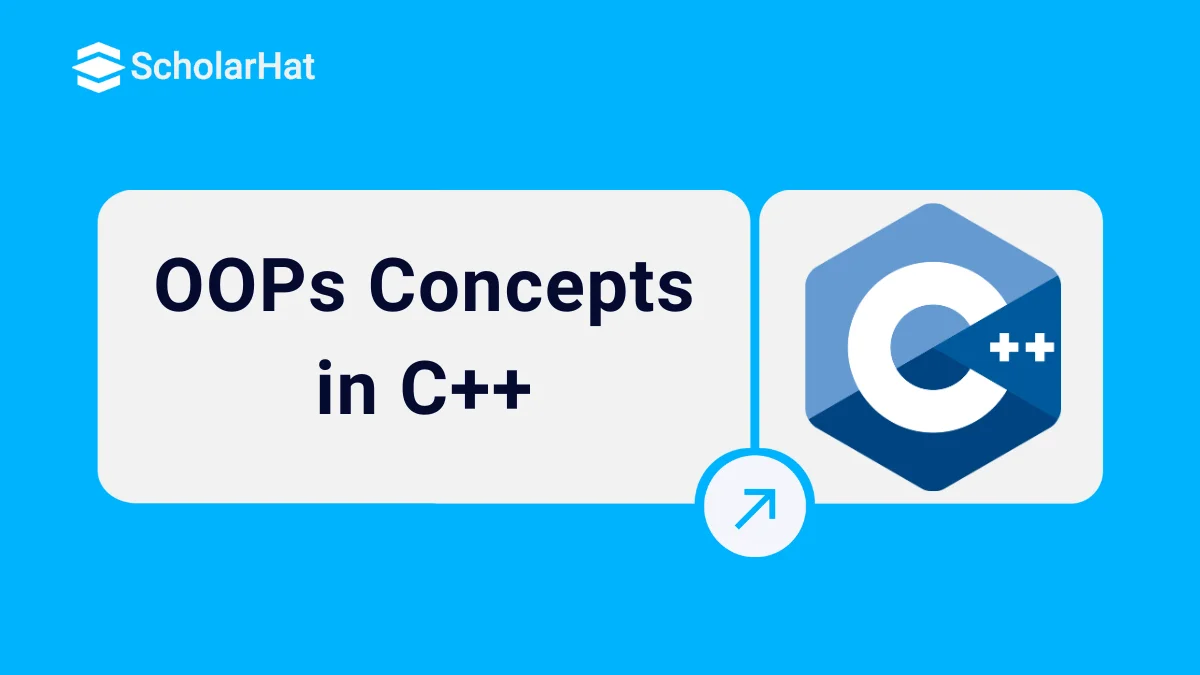26
DecObject Oriented Programming (OOPs) Concepts in C++
OOPs Concepts in C++
Hence In this C++ tutorial, we are going to look at object-oriented programming in cpp concepts in depth. In this approach, the whole world is looked at from the spectacles of objects. Numerous items we come into contact with every day, such as phones & cars, are all objects.
To master these concepts, you can enroll in a free C++ course with certificate and take your skills to the next level!
What is Object-Oriented Programming (OOPs) in C++?
It is a programming paradigm in which everything is represented as an object. OOPs, implement real-world entities in the form of objects. The main aim of OOP is to organize together the data and the functions that operate on them so that no other part of the program can access this data except that function.
Basic OOP Concepts in C++
The concept of OOPs in C++ programming language is based on eight major pillars which are
- Class
- Object
- Inheritance
- Polymorphism
- Abstraction
- Encapsulation
- Dynamic Binding
- Message Passing
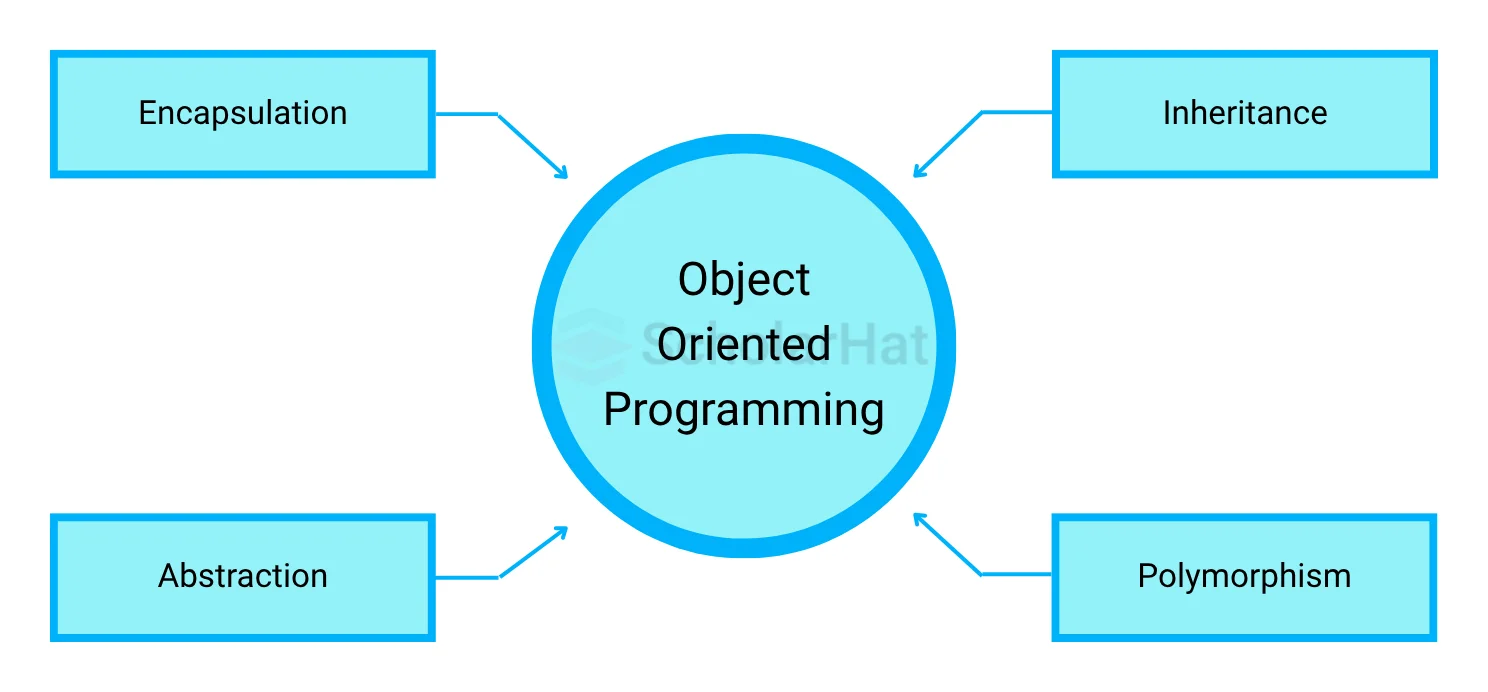
1.) Class

Key Characteristics of a Class
- Encapsulation: A class bundles data (attributes) and functions (methods) together, restricting direct access to some of the object's components and maintaining data integrity.
- Reusability: Once a class is defined, it can be reused to create multiple objects, reducing redundancy and enhancing modularity.
- Abstraction: Classes allow you to hide the implementation details and expose only the necessary features through public methods.
- Inheritance: Classes can inherit attributes and methods from other classes, enabling code reuse and hierarchical relationships.
- Polymorphism: A class can define methods that are overridden in derived classes, allowing for dynamic behavior.
Structure of a Class in C++
A class typically has:
- Data Members: Variables that hold the state of the class.
- Member Functions: Functions that define the behavior of the class.
- Access Specifiers: Keywords (
public,private,protected) to control the accessibility of data members and methods.
Syntax
class ClassName {
private:
// Private data members and methods (only accessible within the class)
public:
// Public data members and methods (accessible outside the class)
// Constructor: Initializes class objects
ClassName() {
// Initialization code
}
// Destructor: Cleans up resources
~ClassName() {
// Cleanup code
}
};
Example: Creating and Using a Class in C++
#include <iostream>
using namespace std;
// Class definition
class Car {
private:
string brand;
int speed;
public:
// Constructor
Car(string carBrand, int carSpeed) {
brand = carBrand;
speed = carSpeed;
}
// Method to display car details
void display() {
cout << "Car Brand: " << brand << ", Speed: " << speed << " km/h" << endl;
}
// Method to update speed
void updateSpeed(int newSpeed) {
speed = newSpeed;
cout << "Speed updated to " << speed << " km/h" << endl;
}
};
int main() {
// Creating objects of the Car class
Car car1("Toyota", 120);
Car car2("Honda", 140);
// Accessing methods of the Car class
car1.display();
car2.display();
car1.updateSpeed(150);
car1.display();
return 0;
}
Output
Car Brand: Toyota, Speed: 120 km/h
Car Brand: Honda, Speed: 140 km/h
Speed updated to 150 km/h
Car Brand: Toyota, Speed: 150 km/h
Key Features in the Example
- Encapsulation: The
brandandspeedvariables are private and can only be accessed or modified through public methods. - Reusability: The
Carclass is used to create multiple objects (car1andcar2). - Data Protection: Direct access to the
brandandspeedattributes is restricted, preventing accidental modifications.
Real-Life Analogy
A class is like a blueprint for a car. The blueprint defines the attributes (e.g., color, speed, brand) and behaviors (e.g., accelerate, brake). Once you have the blueprint, you can create multiple cars (objects) from it, each with unique attributes but sharing the same structure and functionality.
2.) Object
An Object in Oop is a real-world entity that has a particular behavior and a state. It can be physical or logical in C++ programming language. An object is an instance of a class and memory is allocated only when an object of the class is created.
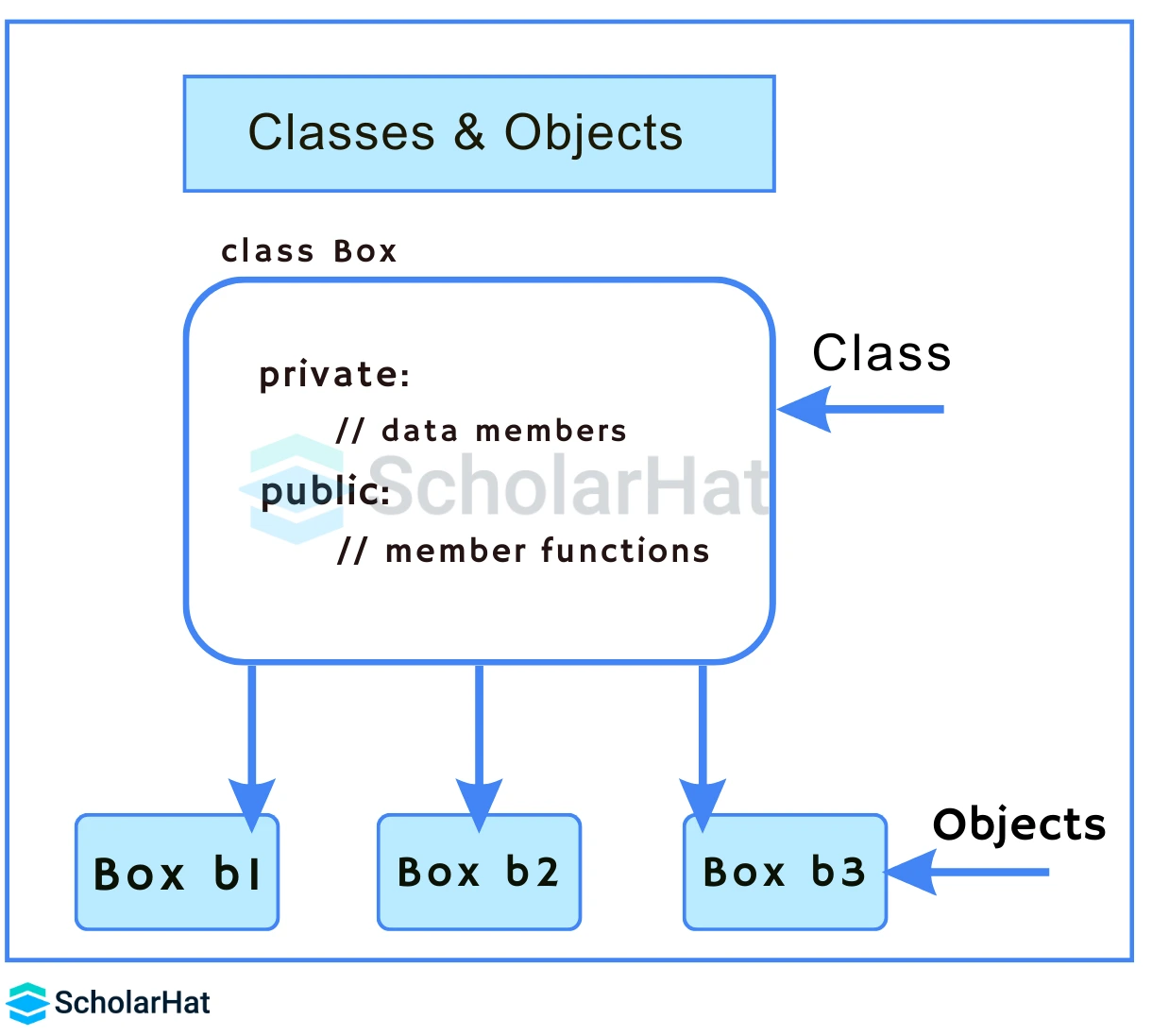
Example illustrating Classes and Objects in C++ Compiler
#include <iostream>
#include <string>
class MyClass { // The class
public: // Access specifier
int num; // Attribute (int variable)
std::string string; // Attribute (string variable)
};
int main() {
MyClass obj; // Create an object of MyClass
// Access attributes and set values
obj.num = 25;
obj.string = "Welcome to ScholarHat";
// Print attribute values
std::cout << obj.num << "\n";
std::cout << obj.string;
return 0;
}
Output
25
Welcome to ScholarHat 3.) Inheritance
It is the phenomenon when a class derives its characteristics from another class. In other words, when an object of a class derives all its properties from the parent object. The class that inherits the properties is known as the child class/derived class and the main class is called the parent class/base class.
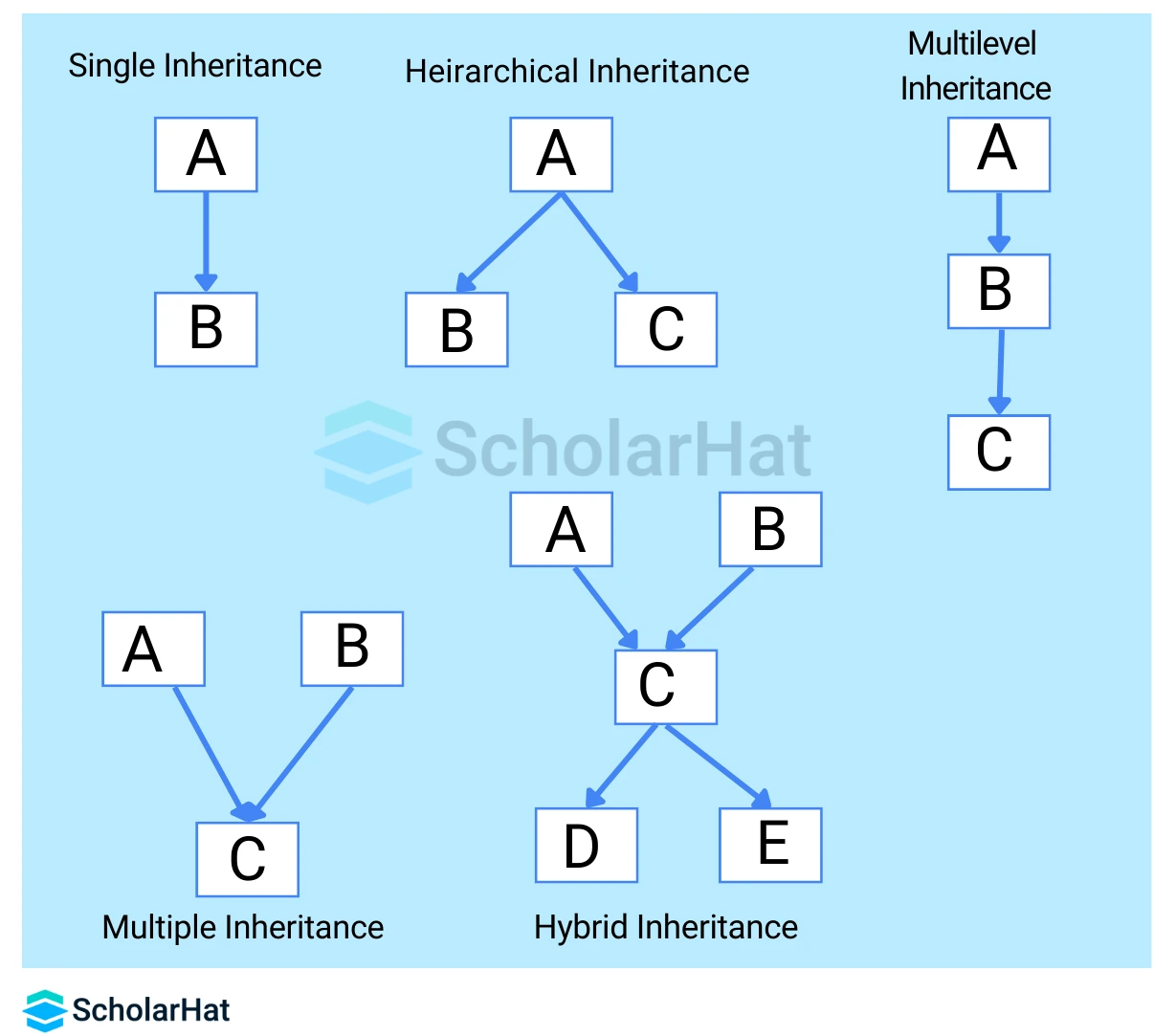
Example illustrating Inheritance in C++
#include <iostream>
using namespace std;
class Polygon {
protected:
int width, height;
public:
void set_values (int a, int b)
{ width=a;
height=b;
}
};
class Rectangle: public Polygon {
public:
int area ()
{ return width * height; }
};
class Triangle: public Polygon {
public:
int area ()
{ return width * height / 2; }
};
int main () {
Rectangle rect;
Triangle trgl;
rect.set_values (7,5);
trgl.set_values (9,7);
cout << rect.area() << '\n';
cout << trgl.area() << '\n';
return 0;
}
Output
35
31
To get into the details of Inheritance, refer to Inheritance in C++ with Modifiers
4.) Polymorphism
Polymorphism means the ability to take more than one form in the C++ programming language. With this feature, you can use the same function to perform different tasks thus increasing code reusability.
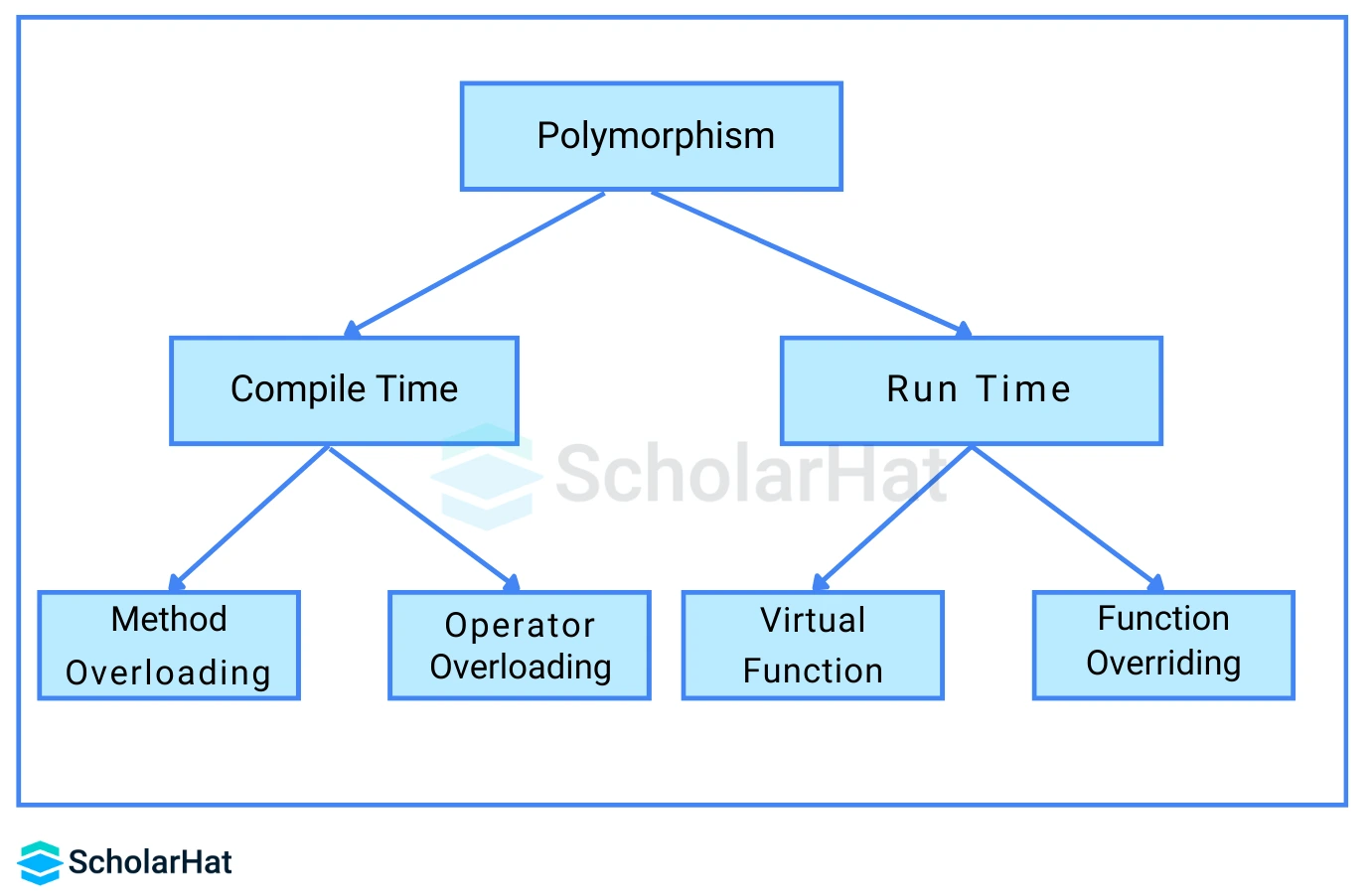
Example illustrating Polymorphism in C++ Online Editor
#include <iostream>
#include <string>
using namespace std;
// Base class
class MangoTree {
public:
void respire() {
cout << "The mango trees do respiration at night. \n";
}
};
// Derived class
class NeemTree : public MangoTree {
public:
void respire() {
cout << "Respiration in neem trees occurs mainly through stomata. \n";
}
};
int main() {
MangoTree myMangoTree;
NeemTree myNeemTree;
myMangoTree.respire();
myNeemTree.respire();
return 0;
}
Output
The mango trees do respiration at night.
Respiration in neem trees occurs mainly through stomata. To get into the details of Polymorphism, refer to Polymorphism in C++: Types of Polymorphism.
5.) Abstraction
Abstraction in C++ programming language helps in the process of data hiding. It assists the program in showing the essential features without showing the functionality or the details of the program to its users. It generally avoids unwanted information or irrelevant details but shows the important part of the program.
Example illustrating Abstraction in C++
#include <iostream>
using namespace std;
class TestAbstraction {
private: string x, y;
public:
void set(string a, string b) {
x = a;
y = b;
}
//printing values
void print() {
cout << "x = " << x << endl;
cout << "y = " << y << endl;
}
};
int main() {
TestAbstraction t1;
t1.set("ScholarHat", "DotNetTricks");
t1.print();
return 0;
}
Output
x = ScholarHat
y = DotNetTricks
To get into the details of Abstraction, refer to Interfaces and Data Abstraction in C++.
6.) Encapsulation
Encapsulation helps to wrap up the functions and data together in a single unit. By privatizing the scope of the data members it can be achieved. This particular feature makes the program inaccessible to the outside world.
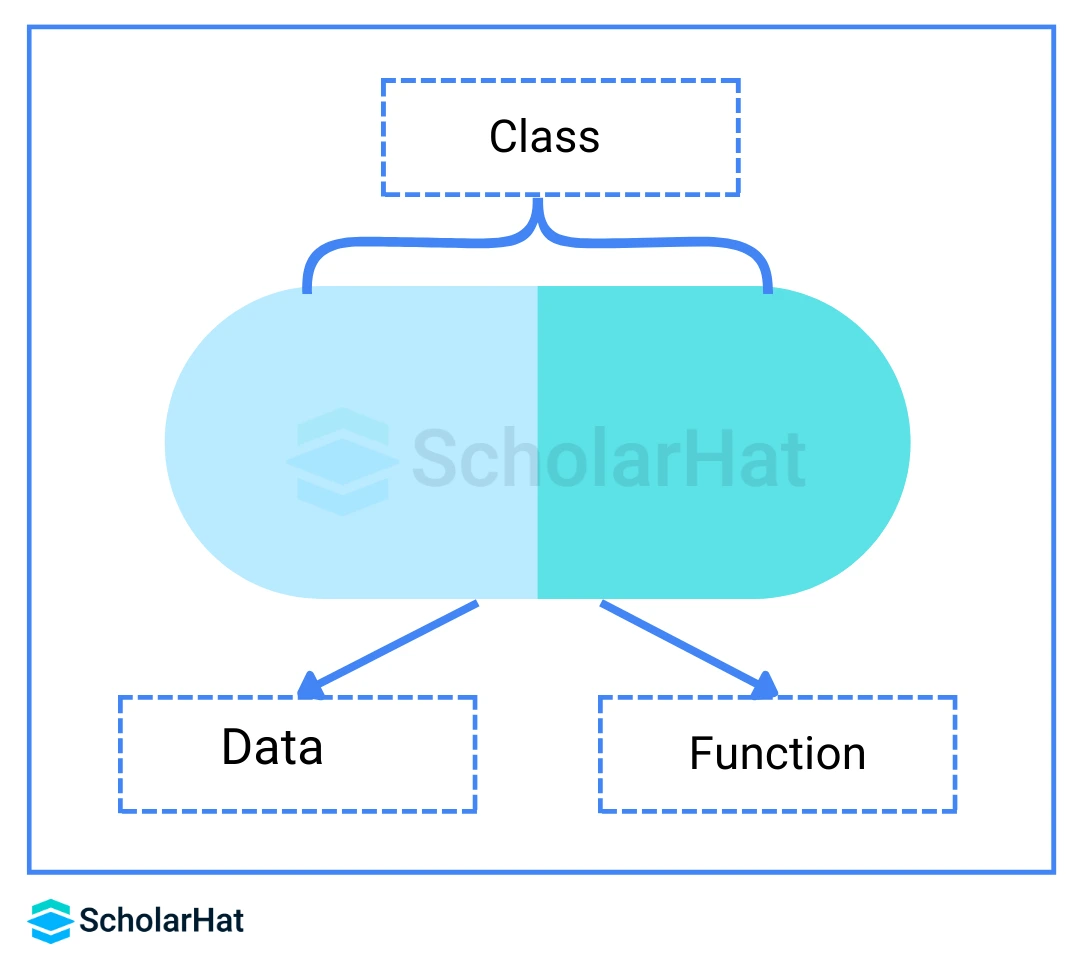
Example illustrating Encapsulation in C++
class MyClass { // The class
public: // Access specifier
int num; // Attribute (int variable)
std::string string; // Attribute (string variable)
// class function
void show_data() {
// code
}; In the above example in C++ Editor, we bundled together the variables num, string, and the function show_data() into a class named MyClass. Encapsulation ensures that only member functions of a class can access its data, which results in data hiding.
In C++, we hide data using private and protected keywords. In contrast, using the public keyword for certain class members makes those members accessible to all other functions and classes.
7) Dynamic Binding
Dynamic binding, also known as late binding, is a key concept in Object-Oriented Programming in C++. It refers to the process of linking a function call to its corresponding function at runtime rather than at compile time. This is primarily used with virtual functions and enables polymorphism, allowing for more flexible and dynamic code.
In dynamic binding in C++, the code to be executed in response to the function call is decided at runtime. C++ has a feature of virtual functions to support this.
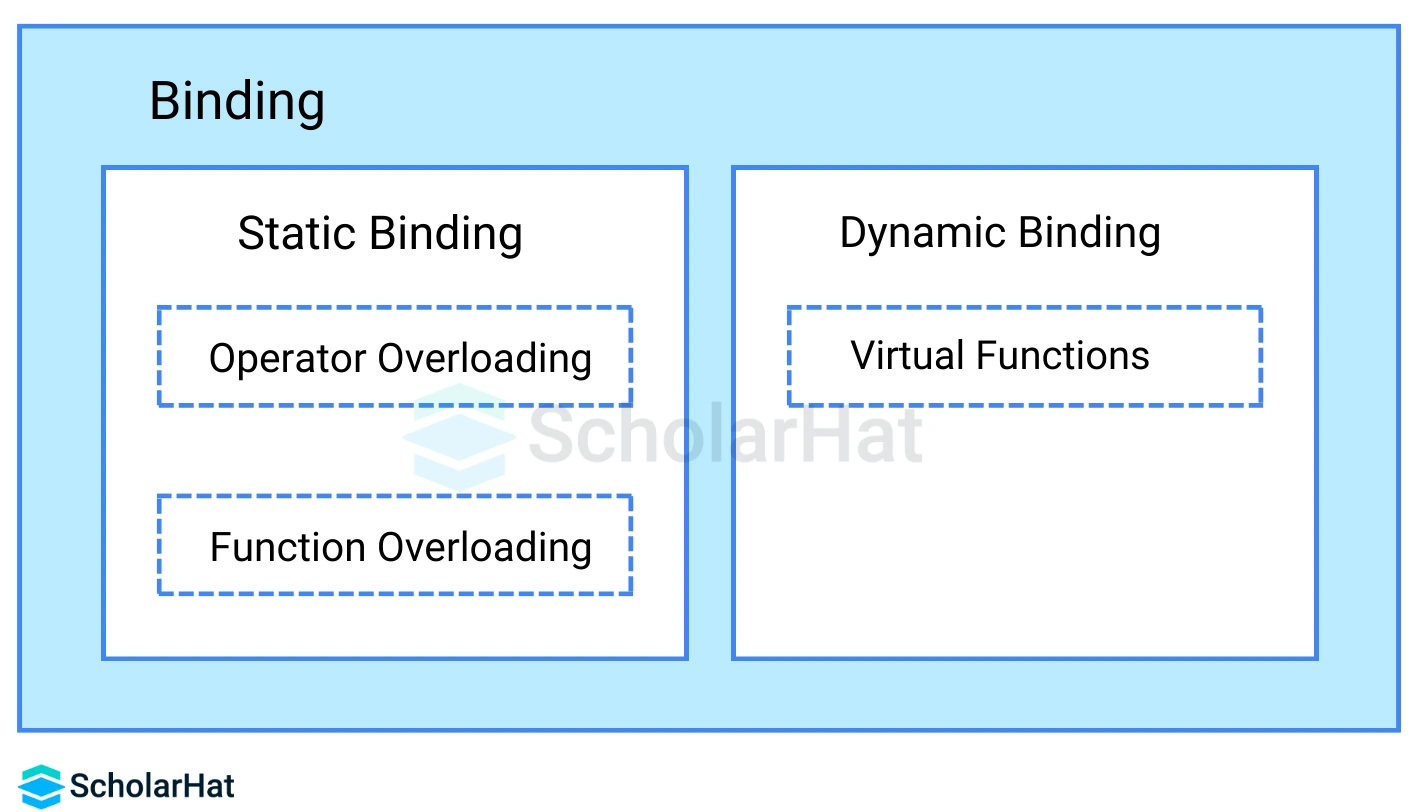
How Dynamic Binding Works
- Virtual Functions: A member function in a base class is declared as
virtualwhen you want derived classes to override it. This signals the compiler to use dynamic binding for this function. - Virtual Table (vtable): The compiler creates a table called the vtable, which stores function pointers for the virtual functions of a class. Each object has a hidden pointer (vptr) to the appropriate vtable.
- Runtime Decision: When a virtual function is called using a base class pointer or reference pointing to a derived class object, the program determines which function to execute based on the actual type of the object at runtime.
Code Example
#include <iostream>
using namespace std;
class Base {
public:
virtual void show() {
cout << "Base class function" << endl;
}
};
class Derived : public Base {
public:
void show() override {
cout << "Derived class function" << endl;
}
};
int main() {
Base* basePtr;
Derived derivedObj;
basePtr = &derivedObj;
// Dynamic binding happens here
basePtr->show();
return 0;
}
Output
Derived class function
Key Points
- The function call
basePtr->show()is resolved at runtime, asshow()is declared as a virtual function. - Without the
virtualkeyword, the base class function (Base::show()) would be executed, as the function call would be resolved at compile time (known as static binding).
Benefits of Dynamic Binding
- Flexibility: Makes code more adaptable to changes.
- Polymorphism: Allows for defining one interface and implementing it differently in derived classes.
- Reusability: Encourages using base class references/pointers for a variety of derived types.
8.) Message Passing
Objects communicate with one another by sending and receiving information from each other. Message passing involves specifying the name of the object, the name of the function, and the information to be sent.
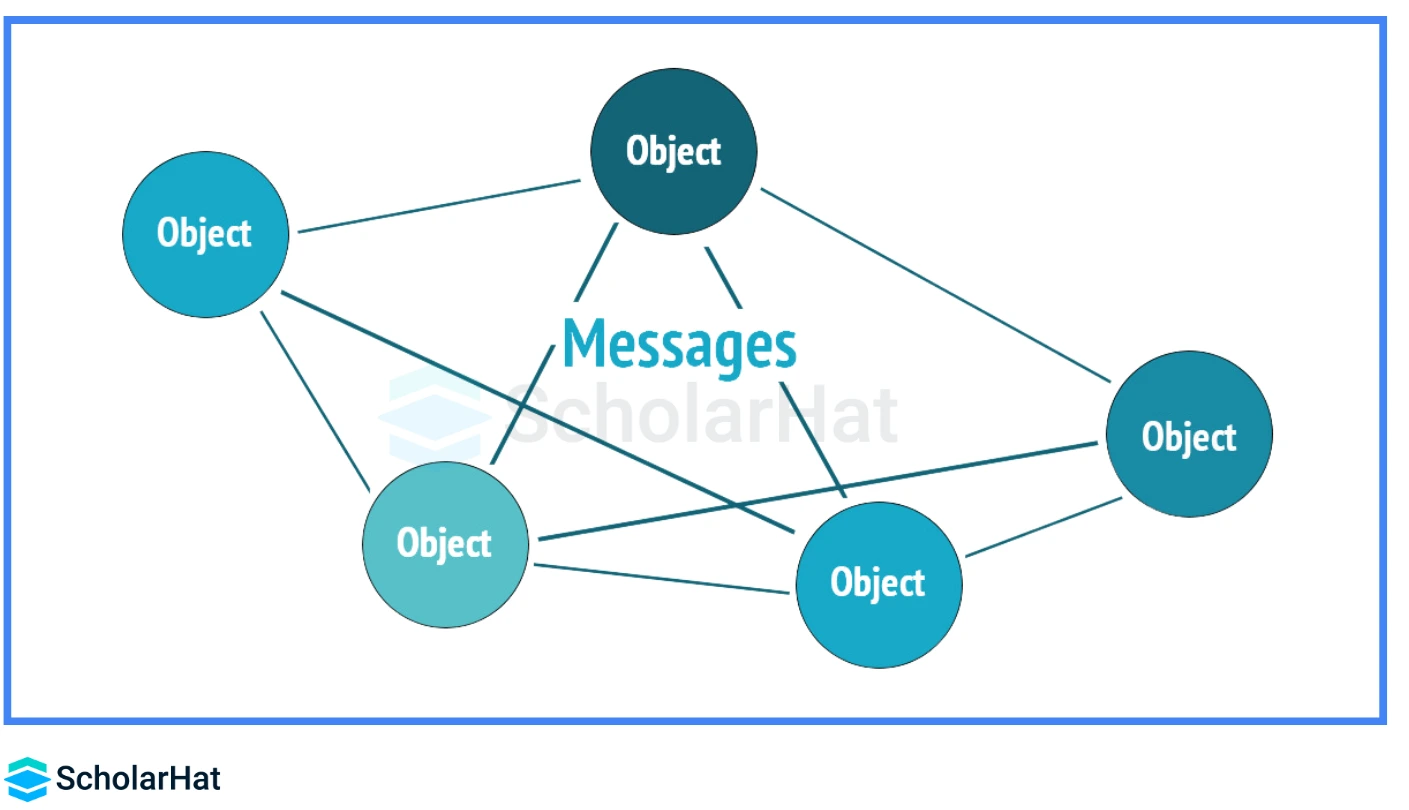
Read More - C++ Interview Questions Interview Questions for Freshers
Message passing is a core concept in Object-Oriented Programming (OOP) that allows objects to communicate with one another. In C++, message passing involves invoking methods (functions) of an object using another object or instance. This mechanism helps in achieving encapsulation and abstraction, making programs modular and easier to maintain.
Key Characteristics of Message Passing in C++
- Object Interaction: Objects send and receive messages by calling member functions defined in their respective classes.
- Encapsulation: The internal state of an object is accessed and modified only through its public methods, ensuring data safety.
- Polymorphism and Overriding: Dynamic behavior can be achieved when derived class objects respond to a message differently using overridden methods.
- Parameters as Messages: Data can also be passed as parameters to the member functions, acting as the content of the "message."
Example of Message Passing in C++
#include <iostream>
using namespace std;
// Class definition
class BankAccount {
private:
string accountHolder;
double balance;
public:
// Constructor
BankAccount(string name, double initialBalance) {
accountHolder = name;
balance = initialBalance;
}
// Method to deposit money
void deposit(double amount) {
balance += amount;
cout << "Deposited: " << amount << ". New Balance: " << balance << endl;
}
// Method to withdraw money
void withdraw(double amount) {
if (amount > balance) {
cout << "Insufficient funds!" << endl;
} else {
balance -= amount;
cout << "Withdrew: " << amount << ". New Balance: " << balance << endl;
}
}
// Method to display account details
void display() {
cout << "Account Holder: " << accountHolder << ", Balance: " << balance << endl;
}
};
int main() {
// Create an object of BankAccount
BankAccount account("Alice", 1000.0);
// Sending messages to the object
account.display(); // Message: display()
account.deposit(500.0); // Message: deposit()
account.withdraw(200.0); // Message: withdraw()
return 0;
}
Output
Account Holder: Alice, Balance: 1000
Deposited: 500. New Balance: 1500
Withdrew: 200. New Balance: 1300
How Message Passing Works
- Object Creation: The
accountthe object is created using theBankAccountclass. - Calling Methods: Messages are passed by invoking the methods
deposit,withdraw, anddisplayon theaccountobject. - Processing Messages: The class processes these messages using its member functions, updating or accessing the private data.
Benefits of Message Passing
- Encapsulation: The internal state is protected, and accessed only through methods.
- Modularity: Functions handle specific tasks, making the code easier to debug and extend.
- Flexibility: Promotes object interaction and supports polymorphism in complex systems.
Real-Life Analogy
Imagine a bank account object as a customer at the bank. The customer sends "messages" (like deposit or withdrawal requests) to the bank, and the bank processes these requests to update the account balance. This is how message passing enables interaction between different entities in a system.
Advantages of OOP in C++
- The OOP provides reusability to the code and extends the usage of the existing classes.
- Object-oriented programming makes it easy to maintain any particular code as there are
objectsandclasses. There is no need to restructure the code. - This particular feature in the C++ programming language also helps in
data-hidingmethods. It is very helpful to keep the data and information safe from getting exposed to leaking. - Object-oriented programming provides the ability to simulate real-world events much more effectively.
Disadvantages of OOP in C++
- As OOP programs are large, they need more time to run, resulting in slower execution.
- OOP is not a universal language, so we can only use it in some places. It is only used when necessary. It is not appropriate for all sorts of issues.
- Everything is represented as an object in OOP, so before applying it, we need to think about objects well.
Procedural Programming vs. Object-Oriented Programming
| Procedure Oriented Programming | Object Oriented programming |
| the program is divided into small parts called functions. | the program is divided into small parts called objects. |
| It follows a top-down approach. | It follows a bottom-up approach. |
| There is no access specifier | It has access specifiers like private, public, protected, etc. |
| The addition of new data and functions is not easy. | The addition of new data and functions is easy. |
| No proper way of hiding data so it is less secure. | Object-oriented programming provides data hiding so it is more secure. |
| overloading is not possible. | Overloading is possible |
| there is no concept of data hiding and inheritance. | The concept of data hiding and inheritance is used. |
| the function is more important than the data. | data is more important than function. |
| It is used for designing medium-sized programs. | It is used for designing large and complex programs. |
| Code reusability is absent in procedural programming, | Code reusability is present in object-oriented programming. |
Summary
This article has made you familiar with OOP in C++ Programming. Understanding how to work with objects and classes is essential for any programmer.
React.js experts are landing ₹20–30 LPA roles while others struggle. Upgrade your skills with our React JS Online Training and secure your future.

